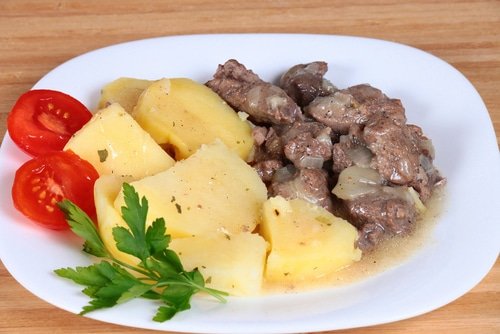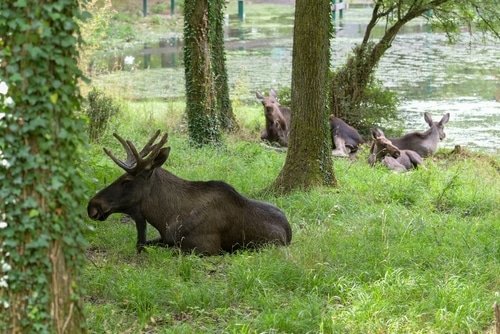Ah, moose stew, the very epitome of wilderness comfort food. Just the thought of a steaming bowl of hearty moose stew can transport you to cozy log cabins nestled in the heart of North America’s pristine forests. Let’s review the best moose stew recipe, per the amazing professionals who created it!
Have you ever wondered how this rustic delicacy came to be? Well, let’s take a delightful stroll through history and uncover the origins of this beloved dish.
Moose stew has a rich heritage deeply entwined with North American culture. Native American tribes were the trailblazers in developing this culinary delight.
They skillfully combined tender cuts of moose meat with an assortment of flavorful ingredients from their bountiful surroundings. This not only satisfied their hunger but also provided warmth and nourishment during cold winter months.
An Overview: Unleashing the Flavors and Techniques
Now that we’ve delved into its past, it’s time to turn our attention to the present – cooking moose stew! To indulge in this scrumptious dish, you need to familiarize yourself with its key components and cooking techniques.
The star ingredient, undoubtedly, is moose meat. Tender and succulent when prepared right, it imparts a unique flavor that sets moose stew apart from any other concoction simmering on your stove.
But let’s not forget about those glorious veggies – onions, carrots, potatoes – all working harmoniously together to create layers of deliciousness. As for cooking techniques, slow and steady wins the race when preparing moose stew.
The low simmer or gentle braise allows all those enchanting flavors to mingle and develop into a symphony for your taste buds. So sit back, relax (or stir occasionally), and let time work its magic!
With our historical journey complete and an overview of the essentials, we’ve set the stage for a mouthwatering exploration of the art of moose stew. Get ready to unleash your inner chef and tantalize your senses with this divine dish that celebrates tradition and the wonders of nature’s bounty.
Understanding Moose Meat
Description of moose meat’s unique flavor and texture
When it comes to the world of game meats, moose is an absolute standout. The flavor of moose meat can be best described as rich and earthy, with hints of sweetness.
Its texture is tender yet robust, making it perfect for slow-cooked dishes like moose stew. The meat itself is leaner than beef, which contributes to its distinctive taste profile.
When cooked properly, moose meat has a melt-in-your-mouth quality that is truly delightful. It’s no wonder why many people consider moose stew a wilderness comfort food.
Discussion on the nutritional benefits of consuming moose meat
Apart from its delectable taste and texture, moose meat also offers several nutritional benefits. One notable advantage is its low fat content compared to other red meats.
This makes it an excellent choice for those seeking a lean source of protein in their diet. Additionally, moose meat is rich in essential nutrients such as iron and B vitamins, including vitamin B12 which plays a crucial role in maintaining nerve function and producing red blood cells.
Incorporating moose meat into your diet can provide these vital nutrients while introducing you to the incredible flavors of nature’s bounty. Understanding the unique flavor and irresistible texture of moose meat serves as the foundation for creating a delicious dish like moose stew.
Not only does consuming this flavorful game offer an experience beyond conventional meats but also provides numerous nutritional benefits that contribute to a well-rounded diet. So let’s dive deeper into gathering ingredients and cooking techniques that will elevate your next wilderness dining experience!
Gathering Ingredients for Moose Stew
Tips on sourcing fresh and high-quality moose meat
When it comes to cooking moose stew, the key to a delectable dish lies in the quality of the main ingredient: the moose meat. Ideally, you want to source fresh moose meat from a reputable supplier or, if you’re feeling adventurous, try your hand at hunting.
In regions where hunting is allowed and regulated, obtaining a hunting license and tag will open up a world of wilderness culinary possibilities. It’s important to remember that moose meat should be handled with care to maintain its freshness.
Look for cuts that are dark red in color, well-marbled with fat, and free from any unpleasant odors. This ensures that your stew will have the best possible flavor and texture.
Selection and preparation of vegetables, herbs, and spices to complement the dish
Creating a harmonious blend of flavors is crucial when it comes to cooking moose stew. To complement the rich taste of moose meat, selecting suitable vegetables is essential.
You can’t go wrong with classics like onions, carrots, celery, and potatoes. These foundational vegetables provide both texture and flavor complexity in every bite.
Consider choosing organic produce whenever possible; their vibrant colors and robust tastes will elevate your stew to new heights. Additionally, don’t forget about herbs and spices!
Fresh thyme adds an earthy aroma while bay leaves infuse a hint of sweetness into the broth. A touch of smoked paprika can lend a subtle smokiness reminiscent of cooking over an open fire in the wilderness.

Preparing Moose Meat for Stewing
Techniques for tenderizing tough cuts of moose meat
When it comes to cooking moose stew, proper preparation of the meat is essential to ensure a melt-in-your-mouth experience. Moose meat, especially certain cuts like the shoulder or hindquarters, can be quite tough.
But fear not, there are a few tried-and-true techniques that will help you achieve tender perfection. One popular method is marinating the moose meat before cooking.
A marinade acts as a flavor enhancer while also tenderizing the tough fibers. You can use ingredients such as vinegar, wine, citrus juices, or even yogurt to break down the connective tissue and make the meat more tender.
Simply combine your choice of marinade ingredients with some herbs and spices in a ziplock bag or a bowl, add the moose meat, and let it marinate in the fridge for at least a couple of hours or overnight if possible. Another technique that works wonders is using acidic ingredients like lemon juice or buttermilk in combination with low and slow cooking methods.
The acid helps to break down tough proteins while infusing delightful flavors into the meat. For example, you can soak your moose cubes in buttermilk for an hour before simmering them gently in broth until they become fork-tender.
Marinating options to enhance flavor and tenderness
Marinating not only aids in tenderizing tougher cuts of moose meat but also infuses it with delightful flavors that complement its natural richness. There are endless possibilities when it comes to creating flavorful marinades for your moose stew.
Consider using red wine as a base for your marinade—it not only adds depth of flavor but also helps tenderize the meat due to its natural acidity. Combine red wine with aromatic herbs like rosemary and thyme along with crushed garlic cloves to create a fragrant and tenderizing marinade.
For those who prefer sweeter flavors, a combination of maple syrup, soy sauce, and ginger can work wonders. The sweetness of the maple syrup adds a unique twist to the moose meat while the soy sauce provides richness and umami notes.
Ginger lends its bright and slightly spicy flavor to balance out the sweetness. Experiment with different marinade ingredients like Worcestershire sauce, balsamic vinegar, or even coffee!
Remember to let the moose meat marinate for an adequate amount of time so it can absorb all those delightful flavors. Preparing moose meat for stewing might require some extra effort, but trust me, it’s worth it.
These techniques will transform tough cuts into tender morsels that will make your moose stew a true wilderness comfort food experience. So go ahead and give them a try – your taste buds will thank you!
Cooking Techniques for Moose Stew
Step-by-step instructions on how to properly brown the meat
When it comes to cooking moose stew, browning the meat is a crucial step that adds depth and richness to the final dish. To start, heat some oil or fat in a large, heavy-bottomed pot over medium-high heat. Make sure your moose meat pieces are patted dry with paper towels before adding them to the pot.
This ensures a good sear and prevents excessive moisture from interfering with browning. Working in batches, place the meat in the pot without overcrowding it, allowing each piece enough space.
Let it cook undisturbed for a few minutes until a golden-brown crust forms on one side. Then flip the pieces over and repeat the process until all sides are evenly browned.
Importance of searing for flavor development
Searing the moose meat is not just about creating an appetizing color; it’s also essential for enhancing flavor development in your stew. When you apply high heat to the surface of the meat, a chemical reaction called the Maillard reaction occurs.
This reaction creates new flavors and aromas by breaking down proteins and sugars present in the meat. As a result, you achieve those delightful savory notes that add complexity to your wilderness comfort food masterpiece.
Tips for achieving a perfect golden-brown crust
To achieve that perfect golden-brown crust on your moose stew meat, there are a few tips you should keep in mind. Firstly, make sure you’re using an adequately heated pot or pan as this will help create those beautiful caramelized flavors without sticking or burning. Secondly, avoid overcrowding your pot when browning as this can lead to steaming rather than proper searing due to excessive moisture from overcrowding.
Resist moving the meat around too often while it’s browning. Allow each piece to develop a crust before flipping it, ensuring that all sides get a chance to turn beautifully brown.
Deglazing the pan to capture all those delicious flavors
Once you’ve finished browning the moose meat and removed it from the pot, don’t let those delicious flavors go to waste. To capture every bit of goodness, deglaze the pan by adding a liquid such as red wine, stock, or even water.
The liquid will help loosen and dissolve any browned bits stuck to the bottom of the pot, known as fond. This step is crucial because those browned bits are packed with concentrated flavor.
Scrape them off with a wooden spoon or spatula while stirring in your chosen liquid. As you continue cooking your moose stew, these flavors will blend harmoniously into a luscious sauce that will elevate your dish from good to outstanding in no time.
Overall, mastering these cooking techniques is key to creating a moose stew that bursts with rich flavors and tender meat. So take your time during the browning process, pay attention to detail, and remember to capture all those wonderful flavors when deglazing the pan.
Flavorful Additions to Enhance Moose Stew
Choosing Aromatic Vegetables: Onions, Carrots, and Celery
When it comes to cooking moose stew, choosing the right vegetables is essential to create a harmonious medley of flavors. Onions, with their sweet and savory notes, provide a solid base for the stew.
They add depth and richness that complement the earthy taste of the moose meat. Carrots bring a touch of sweetness and vibrant color to the dish while imparting a subtle hint of earthiness.
They also help tenderize the meat as they cook alongside it. And let’s not forget about celery!
This humble veggie adds a refreshing crunch and contributes its unique aromatic qualities to the stew. Together, these vegetables form a holy trinity of flavors that enhances the overall taste experience.
Exploring Various Herbs and Spices That Pair Well with Game Meats
To truly elevate your moose stew into a culinary masterpiece, you must explore the realm of herbs and spices. Bay leaves are like little flavor powerhouses that infuse your stew with their warm, floral notes. Thyme adds an earthy aroma that complements both game meats and vegetables perfectly.
Rosemary brings its distinct pine-like fragrance, adding depth while balancing out any gaminess in the meat. A sprinkle of freshly ground black pepper lends a subtle kick that enhances all other flavors present in your pot of simmering goodness.
As for spices, nothing beats a dash of smoked paprika or a pinch of cayenne pepper for some smoky heat or gentle spice respectively—truly transforming your moose stew into wilderness comfort food at its finest. Now armed with this knowledge on flavorful additions for your moose stew recipe, you’re ready to embark on an unforgettable culinary adventure!
Slow Cooking Methods: Simmering vs Braising
Understanding the differences between simmering and braising
Simmering and braising are two popular slow cooking methods that can bring out the best flavors in your moose stew. Understanding the differences between these techniques is crucial to achieving that perfect, melt-in-your-mouth tenderness. Simmering involves gently cooking the stew over low heat, just below boiling point.
This method allows the ingredients to slowly meld together and develop rich flavors while maintaining their texture. On the other hand, braising involves searing the meat first, then covering it with a flavorful liquid and cooking it on low heat for an extended period.
The liquid ensures that the meat stays moist as it tenderizes over time. Both methods have their own unique benefits, so let’s explore them further.
Advantages of each method when preparing moose stew
Simmering your moose stew offers several advantages worth considering. By cooking at a lower temperature, simmering helps retain more of the moisture in your ingredients while allowing them to break down gradually for a well-rounded flavor profile.
The gentle heat also ensures that tough cuts of moose meat become tender without losing their texture completely. Additionally, simmering allows you to infuse all those wonderful aromatics into your stew, creating a comforting aroma that fills your kitchen.
Braising, on the other hand, brings its own set of advantages to cooking moose stew. By first searing the meat before adding liquid and reducing heat, you create a beautiful crust on its exterior that adds depth and complexity to every bite.
Furthermore, braising allows tough cuts like shoulder or shank to transform into tender morsels by breaking down collagen slowly over a longer period of time. Remember that whether you choose simmering or braising as your preferred method for cooking moose stew, both techniques can result in a delectably hearty dish that exemplifies wilderness comfort food at its finest.
Variations on Moose Stew Recipes
Exploring regional variations across North America
When it comes to moose stew, different regions of North America have put their own spin on this wilderness comfort food. Take, for example, the Alaskan moose stew.
In the chilly Alaskan climate, hearty ingredients like potatoes and root vegetables are often added to create a stick-to-your-ribs dish that warms you from the inside out. The Yukon-style moose stew takes a slightly different approach by incorporating wild mushrooms and berries for a unique earthy and slightly sweet flavor profile.
If you head further east into Newfoundland and Labrador in Canada, you’ll find a twist on tradition with Jiggs’ dinner, which includes moose meat cooked alongside salted beef and an assortment of vegetables like cabbage, carrots, turnips, and potatoes. Each region brings its own cultural influences to cooking moose stew, resulting in delightful variations that cater to local tastes.
Creative twists on traditional recipes
While honoring tradition is important in cooking moose stew, there’s always room for culinary creativity. Some adventurous chefs have taken the concept of this hearty dish to new heights by adding unexpected ingredients or using unconventional techniques.
For those seeking a touch of elegance, one might find themselves drawn to a recipe that infuses some red wine into the broth while simmering or adds a splash of brandy at the end for an extra layer of richness. On the other hand, more daring cooks might experiment with unique spices such as cumin or smoked paprika to give their moose stew an enticing twist.
For those looking for an international fusion twist on this classic dish, they might be intrigued by incorporating Asian flavors by adding ginger and soy sauce into the mix; or perhaps experimenting with Mediterranean herbs like rosemary and thyme alongside sun-dried tomatoes for a burst of flavor. The possibilities are as vast as the wilderness itself when it comes to reimagining moose stew recipes.
Tips for Serving and Pairing Moose Stew
Serving Moose Stew with Style
When it comes to serving up a hearty bowl of moose stew, presentation is key. Start by ladling the steaming stew into rustic, earthy bowls that exude warmth and comfort.
Top each serving with a sprig of fresh herbs, such as thyme or rosemary, for a touch of elegance. Accompany your creation with a side of freshly baked bread or fluffy biscuits to mop up every last drop of that rich gravy.
For an extra dash of flavor and texture, sprinkle some crumbled bacon or grated cheese on top. Your guests will be delighted by this delicious wilderness comfort food.
Pairing Moose Stew with the Perfect Beverage
To complement the robust flavors of moose stew, consider pairing it with a beverage that harmonizes well with game meat. A full-bodied red wine like Cabernet Sauvignon or Syrah can provide a lovely contrast to the richness of the dish.
If you prefer something non-alcoholic, opt for a dark beer like stout or porter, which can bring out the earthiness in both the meat and vegetables. If you’re feeling adventurous, try adding a splash of maple syrup to your hot tea or coffee for a sweet twist that pairs surprisingly well with moose stew.
Conclusion
As we conclude our exploration into cooking moose stew, we are reminded not only of its traditional roots but also its ability to warm hearts and bring people together around comforting food. From understanding the unique qualities of moose meat to gathering ingredients and employing various cooking techniques, preparing this wilderness delicacy requires passion and patience but rewards us generously in return—a hearty dish bursting with flavors reminiscent of vast forests and rugged landscapes.
So gather around your table, savor every spoonful, and let the comforting aroma of moose stew transport you to the untamed beauty of the great outdoors. Happy cooking!






